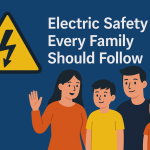
8 Safety Tips for Car Adventurers
Our highways are continuously getting congested as a large number of people now own cars. Drivers, especially the car adventurers, are now more vulnerable to accidents on the busy highways. Reports suggest that approximately 1.3 million road fatalities occur around the world every year leading to fatal injuries and deaths. As per the report of National Highway Traffic Safety Administration, car accidents have cost the US $242 billion in economic activity in one year alone. Other factors like lost workplace productivity and the staggering cost of injuries and loss of life have made many people afraid of driving.
Improvements in technology will continue to mitigate the resulting financial, social and health losses. The bottom line remains that most of these accidents are a result of human error. The best way to reduce risk is to follow defensive driving behavior. We have compiled other safety tips that you should follow to avoid accidents and keep the ensuing losses at a minimum.
Table of Content
Perform regular car maintenance
Proper vehicle maintenance is critical to your safety. Failing routine maintenance can lead to defects that make your vehicle more prone to accidents. Additionally, it significantly deteriorates the driving experience. Apparently minor faults can, in the long run, lead to repair costs higher than the net worth of the vehicle. The scrap car UK industry scraps over 2 million cars every year. Your car may soon end up on the scrapheap if it is not kept well maintained.
Follow the speed limits
Car adventurers often get tempted to hit the paddle but as the old public service campaign puts it ‘speed kills.’ Speed limits aren’t just arbitrary numbers; instead, they are heavily researched controls aimed at ensuring safer drives. According to NHTSA, speeding is the second most prevalent factor in road fatalities, with an economic cost of $40.4 billion to society every year.
Staying within the speed limits not only ensures your safety but also keeps the roads safe for others. Rapid acceleration and braking can lower your car’s performance and mileage by as much as 33 percent. This means you will be spending more on the fuel and vehicle’s maintenance, which can be a significant blow to your finances.
Wear your seat belt
Even a low-speed crash can cause severe injuries by careening an unbelted person into the dashboard or the side window. Such a crash can result in head injuries and broken bones. At higher speeds, the probability of getting a severe injury in the crash becomes even higher. Wearing a seat belt decreases the risk of fatal injury in accidents by as much as 60 percent.
According to NHTSA statistics, more than half of the crash fatalities included people who were not wearing seat belts. In 2015 alone, among the 35,092 crash-related deaths in the US, 16,800 (48%) of them weren’t wearing their seat belts. Make sure you always wear a seat belt while driving and ask the passengers in the back seat to buckle up as well.
Take precautions in bad weather
If you are driving through fog, snowstorm, rain, or on icy roads, you need to extra careful. Such conditions are unfavorable for driving, and you need to be extra cautious and vigilant to ensure safety. Drive slower, keep more distance between vehicles, and take extra care in such conditions. If you aren’t familiar with driving in bad weather, delegate the driving duties to someone who has experience driving in extreme weather conditions. However, if visibility is too low, pull over at the roadside, turn on your indicators, and wait for a while until things get normal.
Don’t follow too closely
Keep a safe distance between yourself and the car in front of you. It allows you to react timely in case the other vehicle makes a sudden turn or stops. The safe distance depends on your speed, so experts rather recommend a ‘three-second rule.’ Tailgating is a major cause of accidents and can result in severe injuries if you are driving at high speed on a busy highway.
Get rid of distractions
Research indicates that engaging in distracting activities can double the risk of accidents. Many states have rightly passed laws that ban the use of cell phones while driving. This seemingly harmless activity results in more than 2,600 deaths every year in the US alone. These numbers may have risen, given the recent prevalence of smart devices. Other distractions include reading, eating or drinking, reaching for something in the car, and driving while you are angry, sad or emotional.
Don’t drive drowsy
Researchers at Virginia Tech found that 20 percent of all accidents have drowsiness as a contributing factor. If a driver is tired, he may fall asleep while driving, and the consequences are predictable. Even a few yawns and being a little drowsy increase your risk of getting in a crash. The best solution is to get proper sleep before you get behind the steering wheel.
Drowsiness can also be caused when you are under the influence of drugs. It slows down your reflexes and lessens your mental awareness. Hence, you can no longer fully focus on driving. Make sure you are completely alert and able to make quick, accurate judgments while driving. No wonder some of the nastiest crashes involve drivers driving under the influence of drugs and alcohol.
Do not drive when stressed or unwell
If you are stressed, fatigued or out of sorts for some reason, you should avoid driving. Any of these will slow down your reaction time, which makes driving in such a state unwise. Being stressed or overworked also increases the chances of you falling asleep during driving. If you feel tired on a long drive, better pull over and rest for some time before you resume your journey.
Conclusion:
Though accidents will continue to happen for one reason or another, their frequency can be significantly declined by following these safety tips. These tips and a little vigilance behind the wheel will ensure that you arrive at your destination unharmed.


